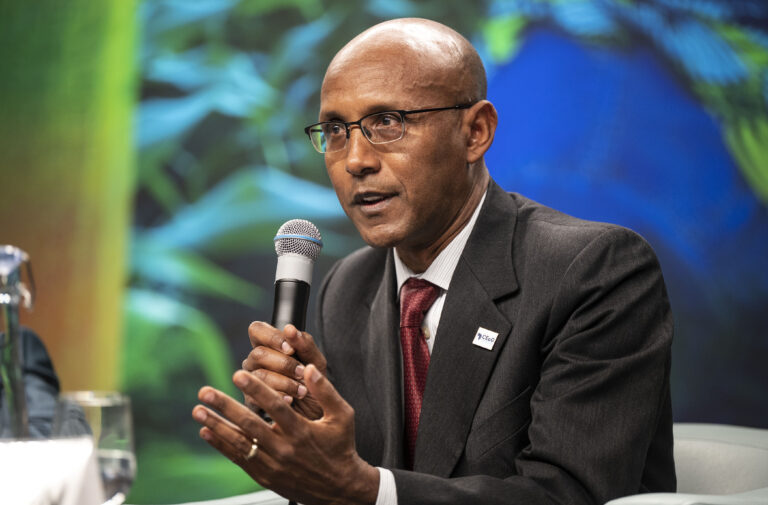
Former UoN’s Council Chairperson, Prof Amukowa Anangwe. Photo/Handout
By Newsflash Writer
In 2019, French President Emmanuel Macron made a significant visit to the University of Nairobi, where he addressed students at the historic Taifa Hall.
This marked the beginning of a crucial partnership between Kenya and France, culminating in the launch of an academic exchange programme that saw 22 Kenyan students travel to Paris.
During the final leg of his two-day visit on March 14, President Macron held a meeting with then-Education Cabinet Secretary Amina Mohammed. The discussions led to agreements on several collaborative initiatives, particularly in scientific research, between French institutions in Kenya and the Ministry of Education.
Unbeknownst to many at the time, the visit would lay the foundation for a Sh18 billion investment in a transformative project aimed at revolutionising STEM (science, technology, engineering, and mathematics) education in Kenya.
By 2021, the French government had committed Sh5.5 billion toward the construction of a state-of-the-art Engineering and Science Complex at the University of Nairobi’s Chiromo Campus. The facility was to mirror a similar research centre at Harvard University, also funded by French partners.
Spanning 30,000 square metres, the complex was envisioned to include precision engineering labs, oil and gas research hubs, tech incubators, and advanced science facilities. It would also house postgraduate hostels, a modern hotel, and lecture theatres, all integrated with advanced ICT systems.
Delays, politics and campus turmoil
Despite its lofty ambitions, the project has been marred by internal power struggles, institutional politics, and severe delays. Initially, ground-breaking was scheduled for 2024 with a 2027 completion timeline. However, Newsflash has learned that construction will now begin in May 2026—three years behind schedule—with President Macron expected to officiate the launch.
The delays are partly attributed to internal wrangles that have already led to the ousting of Vice Chancellor Prof Stephen Kiama and the recent dissolution of the University Council under Prof Amukowa Anangwe. Sources within the University of Nairobi and the Ministry of Education, along with documents reviewed by Newsflash, indicate that the project’s control has become a battleground for influence within the institution.
Also read:State House hand in Anangwe’s resignation from UoN
At the heart of the tensions is a broader fight over Sh200 billion worth of university assets. These include expansive land holdings and high-value properties across Nairobi. Insiders claim powerful external actors are eyeing the assets, creating pressure that could destabilise Kenya’s leading university.
According to project documents, the initial idea was birthed under then-Vice Chancellor Prof Peter Mbithi in 2015. He assembled a senior team of administrators and academics to craft a comprehensive proposal for funding by Agence Française de Développement (AFD), France’s development agency. A memo from the Directorate of University Advancement dated May 2015 assigned Prof Francis Mulaa to lead a 12-member team, which also included Prof Margaret Hutchinson Jesang, the current acting Vice Chancellor.
The team was tasked with preparing a viable business proposal and a funding request to support the university’s infrastructure expansion. The memo from May 12, 2015, outlined the objective: “Develop a project proposal to request for a credit line in support of training infrastructure expansion needs… and prepare a bankable business plan.”
Although Prof Mulaa was shortlisted for Vice Chancellor in later interviews by the Public Service Commission (PSC), his appointment was later revoked by Jogoo House. Instead, Prof Hutchinson was appointed acting Vice Chancellor. Jogoo House also blocked Mulaa’s elevation to Deputy Vice Chancellor (Academic Affairs).
Sustainable funding model and strategic vision
On May 13, 2015, the core project team, led by Prof Mulaa, held a strategic retreat in Naivasha to align financial and academic objectives. Their goal was to design a proposal that would not only secure funding but also ensure financial sustainability. Part of this strategy involved developing a commercial component comprising 100 fully furnished apartments, each to be rented at Sh100,000 monthly, and 1,000 executive studio units charging up to Sh50,000 per month.
According to the documents, this commercial wing was projected to generate Sh1.8 billion annually—sufficient to repay the French loan within ten years. “To ensure sustainability of the project by building modern, secure and family-friendly apartments for commercial renting to enable pay the loan,” one project brief read.
Also read:Govt disowns Ndemo appointment letter as UoN VC
In 2020, the University of Nairobi formalised its partnership with AFD and members of the ParisTech university consortium. A year later, the French Embassy and ParisTech affirmed their financial commitment to the initiative, which also included the creation of eight Centres of Excellence and a complex that would host graduate programmes affiliated with French institutions.
What began as an ambitious academic collaboration has since spiralled into a contentious issue with deep institutional ramifications. As stakeholders push forward with the delayed project, all eyes remain fixed on whether the original vision can still be salvaged amid the swirling political and financial storms.




1 thought on “Inside the Sh18 billion project tearing UoN apart”
Comments are closed.